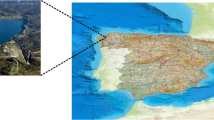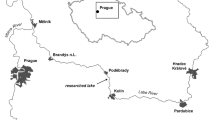Abstract
Following the technical closure of the brown lignite Meirama mine (NW Spain) in April 2008, the reclamation of the mined area is being accomplished with the controlled flooding of its large pit. During the first 7 months of flooding, the sequential arrest of the ground water dewatering system led to the growth of an acidic water body of about 2 hm3. Since October 2008, the surface waters from some local streams have been diverted towards the pit so that these have become the major water input in the flooding process. Surface water has promoted a major change in the chemical composition of the lake water so that, at present, its surface has a circum neutral pH, net alkalinity, and low conductivity. At present, the lake has slightly more than one half of its final volume, and it is expected the overflow in 3 to 3.5 years. The lake is meromictic, with a sharp chemocline separating the acidic monimolimnion (pH ≈ 3.2, acidity ≈ 150 mg CaCO3/L, κ 25 ≈ 2.4 mS/cm) from the main water body (pH ≈ 6.5, alkalinity ≈ 15 mg CaCO3/L, κ 25 ≈ 0.3 mS/cm). Oxygen is being depleted at the bottom of the lake so that the monimolimnion became anoxic in January 2011. Above the chemocline, the composition of the lake is similar, but not identical, to that of the flooding stream waters. Close to the surface, some constituents (pH, metals) show strong seasonal variations in coincidence with the phytoplankton growing periods. Those parameters whose limits are legally prescribed comply with the corresponding water quality standards, and they are also consistent with the forecasting results obtained in early modeling. At present, a project considering the construction of an uptake tunnel to exploit the lake is being developed for the emergency water supply of the metropolitan area of A Coruña.









Similar content being viewed by others
References
APHA (1998) Standard methods for the examination of water and wastewater, 20th edn. American Public Health Association, American Water Works Association, Water Environment Federation, Washington
Blodau C (2006) A review of acidity generation and consumption in acidic coal mine lakes and their watersheds. Sci Total Environ 369:307–332. doi:10.1016/j.scitotenv.2006.05.004
Boehrer B, Schultze M (2008) Stratification of lakes. Rev Geophys 46:RG2005. doi:10.1029/2006RG000210
Boland KT, Padovan AV (2002) Seasonal stratification and mixing in a recently flooded mining void in tropical Australia. Lakes Reserv Res Manag 7:125–131. doi:10.1045/j.1440-169X.2002.00176.x
Bowell RJ, Parshley JV (2005) Control of pit lake water chemistry by secondary minerals, Summer Camp Pit, Nevada. Chem Geol 215:373–385. doi:10.1016/j.chemgeo.2004.06.052
Castendyk DN and Eary LE (2009) The nature and the global distribution of pit lakes. In: Castendyk DN, Eary LE (eds) Mine pit lakes: characteristics, predictive modeling, and sustainability. Society for Mining, Metallurgy, and Exploration, Littleton, pp. 1–11
Castendyk DN, Webster-Brown JG (2007a) Sensitivity analyses in pit lake prediction, Martha Mine, New Zealand 1: relationship between turnover and input water density. Chem Geol 244:42–55. doi:10.1016/j.chemgeo.2007.06.004
Castendyk DN, Webster-Brown JG (2007b) Sensitivity analyses in pit lake prediction, Martha mine, New Zealand 2: geochemistry, water–rock reactions, and surface adsorption. Chem Geol 244:56–73. doi:10.1016/j.chemgeo.2007.06.005
Castro JM, Moore JN (2000) Pit lakes: their characteristics and the potential for their remediation. Environ Geol 39:1254–1260. doi:10.1007/s002549900100
Delgado J, Juncosa R, Vázquez A, Falcón I, Canal J, Hernández H, Padilla F, Rodríguez-Vellando P, Delgado JL (2008a) Hydrochemical characteristics of the natural waters associated to the flooding of the Meirama open pit (A Coruña, NW Spain). Mineral Mag 72:107–111. doi:10.1180/minmag.2008.072.1.107
Delgado J, Juncosa R, Padilla F, Rodríguez-Vellando P, Delgado JL (2008b) Modelización predictiva de la calidad química de las aguas del futuro lago de Meirama (Cerceda, A Coruña). Macla 10:122–125
Delgado J, Juncosa R, Vázquez A, Fernández S, Arias MA, González R, Fernández A (2010) Hydrochemical evolution of the Meirama pit lake (NW Spain) after two years of flooding. In: Birkle P, Torres-Alvarado I (eds) Water-Rock Interaction XIII. Taylor and Francis, New York, pp 515–518
Delgado J, Juncosa R, Hernández H, Falcón I, Vázquez A (2011a) Comparative hydrochemistry of five nested catchments located in the upper part of the Barcés river watershed (A Coruña, NW Spain). Appl Geochem 26:S179–S182. doi:10.1016/j.apgeochem.2011.03.097
Delgado J, Juncosa R, González R, Fernández A (2011b) Fenómenos transitorios asociados a la formación del lago minero de Meirama (La Coruña, España). Bol Geol Min 122:247–258
Denimal S, Bertrand C, Mudry J, Paquette Y, Hochart M, Steinmann M (2005) Evolution of the aqueous geochemistry of mine pit lakes—Blanzy–Montceau-les-Mines coal basin (Massif Central, France): origin of sulfate contents; effects of stratification on water quality. Appl Geochem 20:825–839. doi:10.1016/j.apgeochem.2004.11.015
Eary LE (1999) Geochemical and equilibrium trends in mine pit lakes. Appl Geochem 14:963–987. doi:10.1016/S0883-2927(99)00049-9
EC (2000) Directive 2000/60/EC of the European Parliament and of the council of 23 October 2000 establishing a framework for community action in the field of water policy. Off J Eur Commun L327:1–72
Fyson A, Nixdorf B, Kalin M (2006) The acidic lignite pit lakes of Germany—microcosm experiments on acidity removal through controlled eutrophication. Ecol Eng 28:288–295. doi:10.1016/j.ecoleng.2006.06.012
Gammons CH, Harris LN, Castro JM, Cott PA and Hanna BW (2009) Creating lakes from open pit mines: processes and considerations, with emphasis on northern environments. Canad Tech Rep Fish Aq Sci 2826. http://www.dfo-mpo.gc.ca/libraries-bibliotheques/tech-eng.htm. Accessed 15 Dec 2012
Gibb JP and Evans RL (1978) Preliminary evaluation of final cut lakes. Illinois State Water Survey Circular 130. http://www.isws.uiuc.edu/pubdoc/C/ISWSC-130.pdf. Accessed 15 Dec 2012
Graupner BJ, Benthaus FC, Bürger S, Werner F (2005) Implications of EU-Water Framework Directive for the East German postmining landscape Lausitz: Coping with a sparse knowledge of the underground. Limnologica 35:199–205. doi:10.1016/j.limno.2005.06.004
Hakala A (2004) Meromixis as a part of lake evolution—observations and a revised classification of true meromictic lakes in Finland. Bor Environ Res 9:37–53
Hernández JH, Padilla F, Juncosa R, Rodríguez-Vellando P, Fernández A (2012) A numerical solution to integrated water flows: application to the flooding of an open pit mine at the Barcés river catchment-La Coruña, Spain. J Hydrol 472–473:328–339. doi:10.1016/j.jhydrol.2012.09.040
Hrdinka T (2005) Typology and potential utilization of anthropogenic lakes in mining pits in the Czech Republic. Limnol Rev 7:47–53
Juncosa R, Delgado J, Rodríguez-Vellando P, Padilla F, Vázquez A and Hernández H (2008) Water quality assessment in the reclamation of the Meirama open pit mine, NW Spain. Part II. After-flooding assessment. In: De Santis A, Baker R, Klug B, Vanicek P, Del Rey L, Foyo A, Ercanoglu M and Dordevic D (eds) Environment and Geoscience, Proceedings of the 1st WSEAS International Conference on Environmental and Geological Science and Engineering (EG'08), Malta, 11–13 Sept. 2008. WSEAS Press Malta, pp. 64–69. http://www.wseas.us/e-library/conferences/2008/malta/eg/eg06.pdf. Accessed 15 Dec 2012
Kalff J (2002) Limnology. Prentice Hall, New York
Kirby CS, Cravotta CA III (2005) Net alkalinity and net acidity 2: practical considerations. Appl Geochem 20:1941–1964. doi:10.1016/j.apgeochem.2005.07.002
Koschorreck M, Tittel J (2007) Natural alkalinity generation in neutral lakes affected by acid mine drainage. J Environ Qual 36:1163–1171. doi:10.2134/jeq2006.0354
Maldonado A (1977) Estudio geológico-geofísico del surco Baldayo-Meirama-Boimil. Dissertation, Polythecnical University of Madrid
McCullough CD (2002) Approaches to remediation of acid mine drainage water in pit lakes. Int J Min Reclam Env 22:105–119. doi:10.1080/17480930701350127
Miller GC, Berry-Lyons W, Davis A (1996) Understanding the water quality of pit lakes. Environ Sci Tech 30:118–123. doi:10.1021/es9621354
Nixdorf B, Lessmann D, Deneke R (2005) Mining lakes in a disturbed landscape: application of the EC Water Framework Directive and future management strategies. Ecol Eng 24:67–73. doi:10.1016/j.ecoleng.2004.12.008
Pellicori DA, Gammons CH, Poulson SR (2005) Geochemistry and stable isotope composition of the Berkeley pit lake and surrounding mine waters, Butte, Montana. Appl Geochem 20:2116–2137. doi:10.1016/j.apgeochem.2005.07.010
Ramstedt M, Carlsson E, Lövgren L (2003) Aqueous geochemistry in the Udden pit lake, northern Sweden. Appl Geochem 18:97–108. doi:10.1016/S0883-2927(02)00068-9
Sánchez-España J, López-Pamo E, Santofimia E, Díez M (2008) The acidic mine pit lakes of the Iberian Pyrite Belt: an approach to their physical limnology and hydrogeochemistry. App Geochem 23:1260–1287. doi:10.1016/j.apgeochem.2007.12.036
Santofimia E, López-Pamo E, Reyes J (2012) Changes in stratification and iron redox cycle of an acidic pit lake in relation with climatic factors and physical processes. J Geochem Expl 116–117:40–50. doi:10.1016/j.gexplo.2012.03.004
Schultze M, Boehrer B, Kuehn B, Büttner O (2002) Neutralization of acidic mining lakes with river water. Verh Int Ver Limnol 28:936–939
Schultze M, Geller W, Wendt-Potthoff K, Benthaus FC (2009) Management of water quality in German pit lakes. In: Proceedings of the Conference Securing the Future and 8th ICARD, June 23–26, 2009, Skelleftea, Sweden. http://www.proceedings-stfandicard-2009.com/pdfer/Martin_Schultze_B4_T3_Management-of-water-quality-in-German-pit-lakes.pdf. Accessed 15 Dec 2012
Schultze M, Boehrer B, Friese K, Koschorreck M, Stasik S, Wendt-Potthoff K (2011) Disposal of waste materials at the bottom of pit lakes. In: Fourie A, Tibbett M, Beersing A (eds) Mine Closure 2011, Proceedings of the Sixth International Conference on Mine Closure, 18–21 September 2011, Lake Louise, Alberta, Canada, vol 1, Mine Site Reclamation. Australian Centre for Geomechanics, Perth, pp 555–564
Werner F, Bilek F, Luckner L (2001a) Implications of predicted hydrologic changes on Lake Senftenberg as calculated using water and reactive mass budgets. Min Water Environ 20:129–139. doi:10.1007/s10230-001-8094-z
Werner F, Bilek F, Luckner L (2001b) Impact of regional groundwater flow on the water quality of an old post-mining lake. Ecol Eng 17:133–142. doi:10.1016/S0925-8574(01)00061-1
Wetzel RG (2001) Limnology: lake and river ecosystems, 3rd edn. Academic Press, San Diego
Wyllie DC, Mah CW (2004) Rock Slope Engineering, 4th edn. Spon Press, New York
Zhao LYL, Lund MA and McCullough CD (2010) Mine Voids Management Strategy (III): A monitoring strategy for pit lakes and connected waters. MiWER/Centre for Ecosystem Management Report 20010–02. Government of Western Australia Department of Water. http://www.water.wa.gov.au/PublicationStore/first/96277.pdf. Accessed 15 Dec 2012
Acknowledgments
Funds for this work have been provided by the Spanish Ministry of Economy and Competitivity (CGL2008-05940/BTE), Xunta de Galicia (10MDS008CT), the European Regional Development Funds 2007/2013, and LIMEISA. Constructive comments from an anonymous reviewer and Prof. Hailong Wang are kindly acknowledged. The views expressed in this paper are attributable solely to the authors, and they do not imply the endorsement by the Xunta de Galicia, the Entidad Pública Augas de Galicia, or LIMEISA.
Author information
Authors and Affiliations
Corresponding author
Additional information
Responsible editor: Hailong Wang
Electronic supplementary material
Below is the link to the electronic supplementary material.
ESM 1
(DOCX 11756 kb)
Rights and permissions
About this article
Cite this article
Delgado-Martin, J., Juncosa-Rivera, R., Falcón-Suárez, I. et al. Four years of continuous monitoring of the Meirama end-pit lake and its impact in the definition of future uses. Environ Sci Pollut Res 20, 7520–7533 (2013). https://doi.org/10.1007/s11356-013-1618-9
Received:
Accepted:
Published:
Issue Date:
DOI: https://doi.org/10.1007/s11356-013-1618-9




